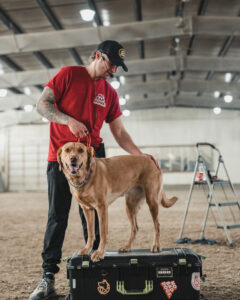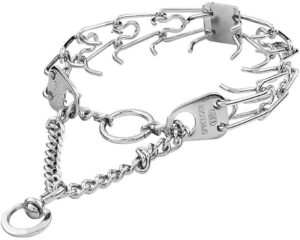
When it comes to teaching your best buddy, safety and efficacy are crucial. You may have come across the Herm Sprenger prong collar if you’ve been looking for a gentle and dependable instrument to help with dog training. Because of its capacity to provide gentle guidance and communication with your canine companion, this training collar has acquired favor among dog owners and trainers alike. However, as with any training tool, it must be used correctly.
Herm Sprenger Prong Collars
It has acquired popularity in the world of dog training as an efficient tool for correcting undesirable habits and improving communication between dogs and their owners. When used appropriately, these collars, which were designed with safety and efficiency in mind, provide a humane method of training. This post aims to provide dog owners with helpful ideas and tips on how to utilize a Herm Sprenger Prong Collar successfully and responsibly. Readers will obtain the knowledge and confidence to use this tool for the enhancement of their dog’s behavior and obedience by knowing the right fit, step-by-step application, and training strategies, and addressing common difficulties.
We’ll go over seven vital guidelines for properly and safely using a Herm Sprenger prong collar.
Introduction to Herm Sprenger Prong Collars

So you’ve got a boisterous puppy who can be a pain to walk? Don’t be concerned, dear friend! The Herm Sprenger Prong Collar could be just what you’re looking for to walk your puppy with. Before you roll your eyes and dismiss this collar as a medieval torture device, let me assure you that it can be a game-changer for your furry pet to walk with.
The Herm Sprenger Prong Collar is a dog correction collar intended to provide a quick release gentle and effective method of controlling your dog’s pulling without inflicting any harm. Its prongs, which may appear frightening at first, function by equally spreading pressure around your dog’s neck. This teaches your dog that pulling causes discomfort, which leads to them walking quietly by your side.
Using a prong collar, such as the Herm Sprenger Prong Collar, can be an effective tool for training and managing strong or energetic dogs. However, it’s important to make proper use of this type of collar to ensure the safety and well-being of your canine companion.
How Does a Herm Sprenger Prong Collar Work?
The Herm Sprenger prong collar is made up of a set of interlocking metal links with prongs that provide pressure on your dog’s neck when the leash is tightened. Don’t worry, these prongs aren’t meant to inflict pain or harm, but rather to resemble how a mother dog corrects her puppies. It’s a gentle prod to get your dog’s attention and say, “Hey buddy, let’s stay focused here.”
Tips For Using a Herm Sprenger Prong Collar
1. Consult a Professional Trainer
Before utilizing a prong choke collar on your dog, you must first contact an experienced dog trainer. They may evaluate your dog’s individual demands and advise you on whether a prong collar is suited for your dog and training objectives.
A skilled professional dog trainer can also show you how to properly utilize the collar, preventing you from accidentally harming your pet.
They can guide you on whether a prong collar is suitable for your dog’s specific needs and teach you how to use it correctly.
2. Choose the Right Size
Herm Sprenger prong collars are available in a variety of sizes and styles, so choosing the right one for the neck size of the collars and your dog is critical. To get the prong collar size correct, first measure your neck. A dog’s weight also plays a role in what gauge collar should be used. Prong collar gauge size ranges from 2.25-3.2mm. A quality, properly fitted prong collar will be both useful and comforting for your dog, minimizing unneeded discomfort or harm.
Ensure the prong collar is fitted properly on the neck of your dog. It should sit high on the neck, just below the ears, and be snug but not too loose or overly tight. A loose or improperly fitted prong collar may not be effective in communicating commands and can also pose safety risks.
Use the prong collar as a training aid, not as a punishment tool. The prongs are designed to simulate the pressure exerted by a mother dog on her puppies’ necks for correction. Give quick and firm corrections, followed by praise/reward when your dog responds appropriately to the command. Verbal markers in conjunction with a physical correction are essential for a dog to grasp the correct behavior.
3. Gradual Introduction
The Herm Sprenger prong collar should be introduced to your dog gradually. Allow your dog to get used to wearing the prong collar without any pressure or correction at first. This will assist your dog in associating the prong collar with happy experiences, reducing any initial discomfort or fear of the prong itself.
4. Proper placement
The correct positioning of the dog’s neck and head in the prong neck collar is critical for its effectiveness and safety. The prong neck collar should fit snugly but not be pulled too tightly around your dog’s neck, right below their ears.
Always handle the prong collar with care and avoid yanking or jerking the leash. Apply controlled and quick pressure to give your dog clear guidance. Avoid overcorrection, as it may cause fear or anxiety in your dog. The physical correction in conjunction with a verbal command will allow the dog to capture the command/behavior you are teaching.
5. Gentle Corrections
A Herm Sprenger prong collar’s principal function is to deliver quick corrections during training. On the leash, avoid exerting undue force or violent jerks. Instead, when your dog demonstrates inappropriate behavior, apply steady, firm pressure with a quick release as soon as your dog responds appropriately. The idea is to communicate with your dog, not to inflict suffering on him.
6. Consistent Training
Whether you use a prong collar or another approach, consistency is essential in dog training. Make certain that all family members and caregivers are on the same page when it comes to training tactics and commands. Inconsistency might confuse and impede your dog’s progress.
7. Positive Reinforcement
The prong collar can be a useful training tool when used in conjunction with positive reinforcement. When your dog demonstrates desired behavior, lavish him with praise, treats, and attention. This positive reinforcement will aid in the reinforcement of your dogs’ good behaviors and the formation of a strong link between you and your furry buddy.
Combine prong collar training with plenty of positive reinforcement, praise, and rewards.
8. Monitor Your Dog’s Reaction
Continuously monitor your dog’s or puppy’s reaction to the prong collar. Look for signs of discomfort, stress, or agitation. If your dog shows signs of distress, immediately discontinue the use of the prong collar and consult with a professional trainer.
9. Use as a Temporary Tool
A prong collar should be used as a temporary training tool, not as a permanent solution. Use it to address specific behavioral issues and teach your dog the desired behaviors.
Using a Herm Sprenger prong collar on your dog can be a wonderful training tool for dogs if done carefully and ethically. Always seek the advice of a skilled trainer, guarantee choke prong collar is a good fit, and emphasize positive reinforcement and verbal markers.
When collars are used correctly and responsibly, a Herm Sprenger Prong Collar can aid an owner in training and managing a strong-willed dog.
Remember to consult with a professional dog trainer, like us! At Upstate Academy we use proper fitting and handling training techniques for dogs and pair them with positive reinforcement for our balanced training approach. With patience and consistency, you can achieve the desired results while maintaining a positive and quality relationship with your furry companion.
Remember, a happy dog is a well-trained dog! Visit our shop https://buynobaddogs.com
